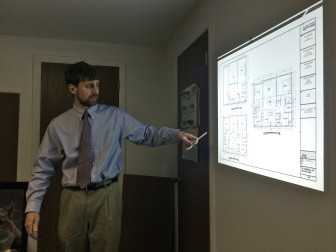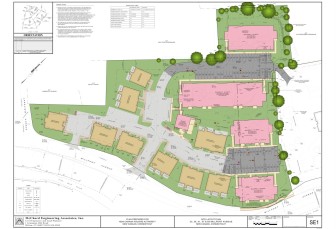A plan to add 33 units to the public housing development at Mill Pond would trigger temporary relief for New Canaan from a state law that often amounts to a loophole for developers seeking to skirt local planning decisions, officials say.

David McCarthy of Jonathan Rose Companies, a Stamford-based firm that’s working in a construction manager capacity with the New Canaan Housing Authority on the Millport redevelopment. Here he’s addressing residents at a Nov. 12, 2014 meeting about the project. Credit: Michael Dinan
Under the Affordable Housing Appeals Act, towns where less than 10 percent of the housing stock qualifies as “affordable” by the state’s definition (New Canaan’s is at about 2.4 percent), developers may bypass Planning & Zoning by designating a percentage of units within proposed new structures as affordable.
Ten percent is a rigorous standard that towns such as New Canaan are unlikely to meet, officials say, since the state in calculating “affordable” lumps the town into the sprawling geography of the “Norwalk-Stamford Metropolitan area.”
Yet there’s a way to get relief under a provision (a complicated provision) in the state law. Under the provision, types of housing are assigned a certain number of points based on variables such as how much they cost (in mortgage payments or rent) and who they serve (seniors or families). If a town amasses enough “housing unit equivalent” points, it can earn a four-year exemption.
The 33 units planned for Mill Pond would trigger the moratorium, according to David R. McCarthy of Jonathan Rose Companies, a Stamford-based firm that’s working in a construction manager capacity with the New Canaan Housing Authority on the Millport redevelopment.
“One of the main incentives for the town to do this project is that by completing these units, the town would be able to get a moratorium from [the Affordable Housing Appeals Act], and we actually calculated that it would take us very far toward a second moratorium,” McCarthy said during a meeting early Wednesday evening of the Housing Authority, held in the agency’s administrative offices at Millport Apartments.

Site plan for Millport Avenue rebuild. The pink areas at the bottom-right are “Phase One” of the project, where 33 units will be built pending town approval. HUD must sign off first on Phase Two of the project, which is located in the two pink-colored areas at the top, where 18 units would be razed and 55 installed. Photo courtesy of Jonathan Rose Companies
It’s an important standard for New Canaan to meet in order to avoid seeing unwanted projects shoehorned into available lots.
Many New Canaanites will recall that a developer had threatened to leverage the Affordable Housing Appeals Act, sometimes called ‘8-30g’ for its specific statute number, in order to develop at Jelliff Mill. In that case, the town ended up approving the development in exchange for $200,000 paid into its fund for creating affordable units.
Fears that the law would be invoked resurfaced when the Roger Sherman Inn hit the market for $6 million in August, and for many those fears remain.
In any case, the moratorium wouldn’t be kickstarted until a Certificate of Occupancy is granted for the Millport Avenue redevelopment—really the first phase of a two-part plan—and that’s still about 18 months away, McCarthy said. (The second part of the plan would see the 18 units “up the hill” at 41 Millport Ave. rebuilt with far greater density, at 55 apartments—a conceptual plan that HUD itself would need to approve.)
For the critical first part of the plan, the Housing Authority will go before three town bodies next week—Inland Wetlands, P&Z and the Town Council. Plans were filed about two weeks ago.

New Canaan Housing Authority Chairman Scott Hobbs (standing, left) addresses residents of Millport Apartments during an information session on the proposed redevelopment project there, Nov. 12, 2014. Credit: Michael Dinan
Many town leaders, including Town Council Vice Chairman Steve Karl—have noted that New Canaan embraces the spirit of creating more affordable units here, especially to house hugely important members of the community that may be priced out, such as emergency responders and teachers.
Certainly, the plan to create new housing at Mill Pond is far more than just a way to beat a state requirement: It’s where scores of fellow New Canaanites live.
About one dozen residents of Millport Apartments came to a portion of the Housing Authority meeting on Wednesday to get details about the overall plan. They raised questions about handicapped access in the proposed new units (they’ll all be ADA-compliant), the possibility of a playground (not part of the plan now, though a 2,000-square-foot community center is planned), parking availability (which will be curtailed somewhat), neighbor noise in multi-level housing, storage (closets will be large, though standalone dedicated personal storage is not planned), washer-drier units (stack-able not full-size), what types of heating and AC are planned (possibly propane heating) and who will pay for moving costs (the Housing Authority).
Housing Authority Chairman Scott Hobbs and McCarthy fielded the questions, and supplied these figures for the residents of Millport Apartments, who would be relocated to the 33 proposed new units if HUD green lights “phase two”: one-bedroom apartments at 750 square feet, two-bedroom “flats” (no loft) at 1,050 square feet and two-bedroom lofts at 1,400 (each with two full bathrooms); and three-bedroom lofts at either 1,500 or 1,600 square feet (with three full bathrooms).
McCarthy called the apartment sizes “generous.”
Specifically, the 33 units would be built where two 2-family homes now stand at numbers 33 and 35 Millport Ave. (formerly the Schmid family’s home, for those who go back a bit).
The residents of Millport said they appreciated the Housing Authority’s transparency and willingness to share information at such an early stage.